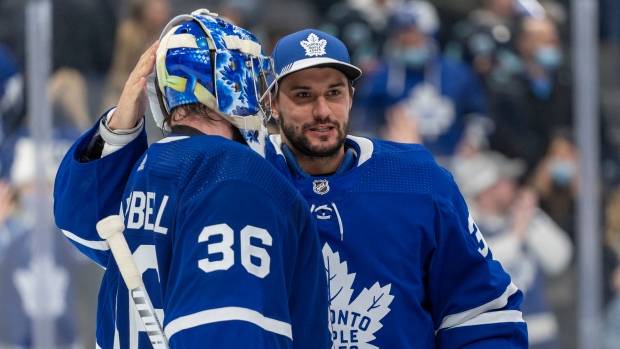Mar 25, 2022
Leafs’ front office decides to gamble in goal
Toronto passed on adding a goalie at the deadline, instead betting on favourable regression from Jack Campbell and Petr Mrazek, Travis Yost writes.
By Travis Yost

How do you define a Stanley Cup contender?
There is no single answer to the question. In fact, ask a hundred people, and I bet you get a hundred different answers.
We understand the core tenets of what differentiates a team to the upside: strong goaltending, star talent, depth competency, and a blueline that can play both ways are all staples of modern contenders. If you check three of those boxes, you are a Cup contender. Four? You’re the odds-on favorite.
The Toronto Maple Leafs have the star talent, indisputably. The blueline is much improved from where it was a few years ago, and that was before the acquisition of veteran defenceman Mark Giordano just ahead of the trade deadline.
The team also has depth: Toronto’s goal differential with Auston Matthews and the first line off ice this year is 98 goals for, 98 goals against. Said differently: Toronto’s depth forwards aren’t hurting the team, and considering how much the team has invested at the very top of the lineup, that’s a considerable achievement.
That brings us to goaltending. Oh, the goaltending. It’s been dreadful in recent months in Toronto, the exact type of scare the Maple Leafs did not need entering the playoff fray.
There was hope that Jack Campbell could commandeer the starter’s net long term; there was similar hope that Petr Mrazek’s game could be resurrected. Now you have depth options like Erik Kallgren getting regular starts. That’s why Toronto was rumoured to be in the mix for Marc-Andre Fleury’s services at the deadline. Ultimately, Toronto passed on further investment.
The reasons for not bringing in a goaltender are multi-faceted. There were few options available, and the options that were available weren’t cheap – Fleury, for example, cost a conditional first-round pick. The team has very little cap flexibility, and there’s an argument to be made that Campbell’s performance could rebound back to career averages.
But make no mistake, the goaltending situation in Toronto is a problem – perhaps a big one. And it’s not one that’s being inflamed by the play of the defenders in front.
What makes us confident that’s the case? Video is telling enough. But the data corroborates this too. Compare this year’s Toronto team to the 2017-18 version that finished with 105 points and note the striking differences in the defensive profiles.
First, 2017-18 (via HockeyViz):

Both Frederik Andersen (91.7 per cent stop rate in 66 games) and Curtis McElhinney (93.2 per cent stop rate in 18 games) had strong seasons in 2017-18, but neither played in favourable conditions. The Maple Leafs blueline was leaky and five-man units played inordinately more in the defensive third than they do now. At year end, Toronto finished 26th in expected goals against and 18th in goals conceded.
This was a bad defensive team that looked average because of responsible goaltending behind them. They were uniquely challenged at even strength, but both Andersen and McElhinney were erasers. In the playoffs, Toronto was bounced in seven games by division rival Boston, giving up a whopping 28 goals in the series.
Now, 2021-22:

This is a fundamentally different group. This Toronto team dominates the puck, but it is also defensively responsible in their own end – a far cry from what we witnessed a few years back. A lot of this has to do with the personnel changes over the years, but it’s not lost on me that Toronto is ninth in expected goals at even strength, and four thin expected goals against on the penalty kill. Shot volume has dropped, and so too have those slot and inner-circle shots that frequently get past goalies.
But Toronto doesn’t have great defensive results. Why? Goaltending, of course. Toronto’s goalies – predominantly Campbell and Mrazek – concede goals at higher rates from most areas of the defensive third. We have seen ugly goals, unlucky goals, and all things in between. But when your team is stopping a tick above 90 per cent of shots faced, any given game can go wrong in a hurry.
So, in one breath you understand why Toronto didn’t make a move on a goaltender. In another breath, you have to recognize it’s the most likely reason the Leafs would incur an early playoff exit.
Compare Toronto’s goals saved above expected (team level) against the rest of the playoff field, and you understand what sort of uphill battle the Maple Leafs are dealing with:

The Leafs are betting on favourable regression for their goalies, starting with Campbell once he returns from injury. They may be rewarded from that bet.
But if they’re wrong, Toronto is likely entering every playoff matchup at a goaltending disadvantage. Perhaps improved defensive play and a blistering, relentless attack can smooth out those concerns. But if they don’t, the Maple Leafs front office will be answering tough questions all summer.
Data via Natural Stat Trick, Evolving Hockey, HockeyViz, NHL.com

